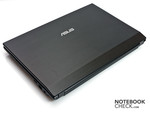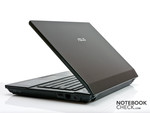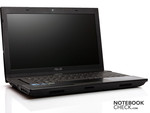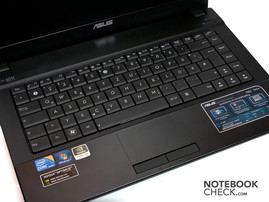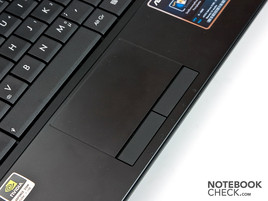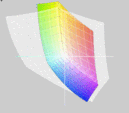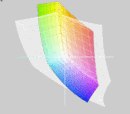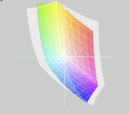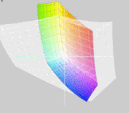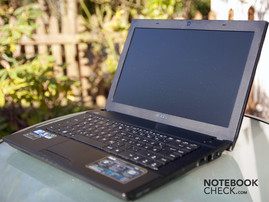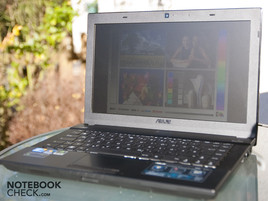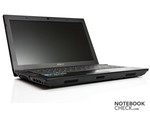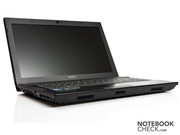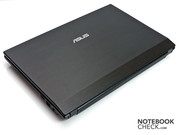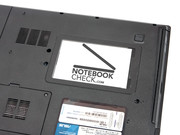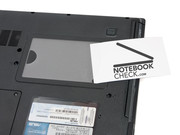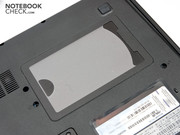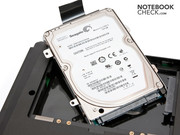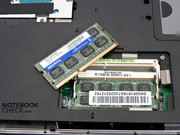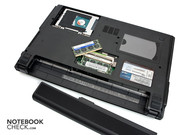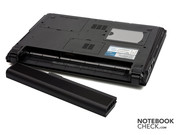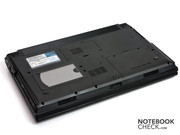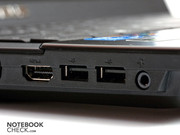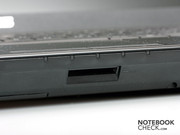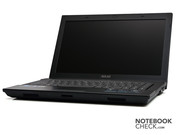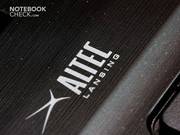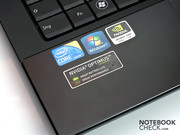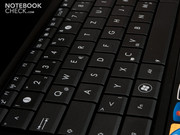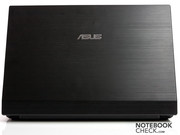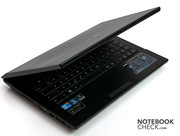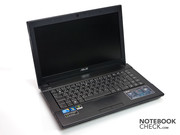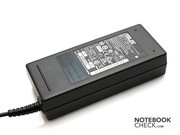Review Asus P42JC Notebook

Asus extends its array of 14 inch notebooks by the P42JC. The P42JC is supposed to especially be aimed at business customers who are looking for a small, light and mobile notebook, and don't want to accept cutbacks in workmanship or materials. The installed Intel Core i5 processor should supply enough performance for most applications. The 14 inch display is a compromise between a clearly arranged desktop and case size.
Asus has even considered the needs of business customers in the single components. Thus, the notebook has a matt display and Nvidia Optimus technology, which is supposed to increase the battery life. The plain design should also look good in many conference rooms.
Case
The Asus P42JC radiates the kind of seriousness that you don't find in many other notebooks at first sight. At the same time it makes a high-end and elegant impression. The entire notebook has been made in black. The display lid is composed of brushed aluminum that had been anodized. Thus, the lid looks very elegant and is also very resistant against fingerprints. Additionally, it gives the lid very good haptics.
Inside, Asus uses a wrist-rest that is also constructed in aluminum and allegedly stays cool even in longer use. However, fingerprints soon gather on the wrist-rest's surface. Otherwise, very well manufactured plastic that also suggests brushed aluminum is used inside. The overall design concept looks coherent and makes a good impression. Consequently, you can take for granted that the notebook will look very good in conference rooms or the office.
Moreover, the notebook excels in our pressure tests. The wrist-rest and areas around the keyboard don't yield at all under selective pressure. Even the keys only give way slightly under stronger pressure, particularly towards the center. On the other hand, the display's aluminum lid proves to be absolutely pressure resistant. No color falsifications or other deviations turn up in the image under selective pressure on the display's back side. However, the display can be twisted quite easily with moderate force.
Connectivity
The Asus P42JC limits itself to the most essential in terms of connectivity. You won't find a large interface range here. Even USB 3.0 or eSATA for high speed connection of external hard disks aren't installed. Three USB ports rather represent the lower end for current notebooks. The omitted extension options, such as an ExpressCard slot, would have been a sensible extension for the notebook.
Thus, the Kensington lock, the VGA out, the HDMI socket, two USB ports and the headphone socket are found on the left. There is no microphone jack, which may have an adverse impact in video conferences. Your telephone partner may have difficulties in understanding anything, especially in less quiet places such as airports.
On the right, the power socket, the RJ45 network interface and the optical drive can be found.
The rear doesn't have any connections and only the 4in1 cardreader is on the front. The cardreader is compatible with SC, MMC, MS and MS Pro.
The interfaces have been arranged that especially righties have a lot of room, even when several devices or USB sticks are connected to the notebook. Those who prefer using their mouse on the left will be confronted with a few more problems. A majority of interfaces have been moved here and could be especially deterring when a monitor or projector is connected to the stationary placed notebook.
Communication
You don't have to worry about communicating with the world outside. The Asus P42JC has everything you'll need. The user has a RJ45 network available for cabled connections. Beside transmission rates of 10 MB/s and 100 MB/s, it also bids 1000 MB/s.
If you prefer wireless communication, you can use the WLAN standard 802.11 b/g/n. For connecting to small appliances like mobiles or wireless mice, Bluetooth (2.0) is also available.
Security
Especially security feature don't exactly play an inferior role for the choice of the right companion in a business notebook. Aside from the mandatory Kensington lock that can protect the notebook against theft (if it's used), there is a shock resistant hard disk and Intel's Anti-Theft and Computrace LoJack.
This is software that runs unnoticed in the background when it's been activated. It regularly transmits the notebook's location information to the Absolute Monitoring Center. If the computer is reported as stolen, the Absolute Theft Recovery Team uses the transmitted data from the notebook to recover the device. In order to use this service, you have to subscribe to Absolute Software. An annual subscription is available for 39.95 euro and a four year subscription costs 79.95 euro. The P42JC however doesn't have a fingerprint reader.
Supplies
The Asus P42JC's scope of delivery is rather sparse. Aside from printed instructions and warranty papers, there is a cable strap and a recovery DVD with driver in the carton.
Warranty
Asus P42JC is granted a warranty of 24 months and is known as Collect & Return Service.
Input Devices
Keyboard
An array of separate keys hasn't been used for the keyboard (chiclet), but rather a "conventional" keyboard layout. The single keys have turned out very large with a size of 17 x 16 millimeters. Typos resulting of too small keys can almost be excluded. A number pad hasn't been built in, which isn't surprising in view of the device's compact size. Nevertheless, Asus includes a very good, feasible keyboard.
The typing feel that is created during writing on the keyboard is also impressive. Pressure point and stroke have been adequately selected in order to even type without fatigue or pain over a longer time. The typing noise is also acceptable and isn't obtrusive or disturbing in quiet surroundings. There aren't many hot keys. The keyboard's right merely accommodates the image up and down keys, the delete key, the home and end key.
Touchpad
The Asus notebook's touchpad was absolutely remarkable. It looks like the aluminum wrist-rest's surface finish and would hardly be noticed if it wasn't delimited. Navigating is very pleasant on the smooth surface. The touchpad bids enough room with a diagonal of almost 94 millimeters. This is also gratefully accepted because of multi-touch. You logically need more room if you use several fingers for navigating.
In return, both mouse keys have turned out very narrow. In the beginning, your finger will frequently end up on the touchpad and not on the key. After a bit of accommodating, the narrow keys aren't a problem anymore and can be used perfectly due to a good pressure point and clearly defined stroke.
Display
As usual for business devices, a matt display has been installed into the P42JC. Although glossy displays aren't completely prohibited by the German Display Screen Equipment Regulation, they are attached to considerably more requirements than matt displays. Especially those who work a lot in surroundings with changing lighting conditions will appreciate a matt display. Additionally, those who like take the notebook to the park or beer garden in the summertime will have a lot more pleasure with a matt display than with a glossy one. The P42JC's has a 14 inch size and a resolution of 1366x768 pixels. Thus, there is enough desktop to work on several adjacent documents, with a bit of effort.
| |||||||||||||||||||||||||
Brightness Distribution: 89 %
Center on Battery: 177 cd/m²
Contrast: 222:1 (Black: 0.88 cd/m²)56% AdobeRGB 1998 (Argyll 2.2.0 3D)
76.5% sRGB (Argyll 2.2.0 3D)
56.4% Display P3 (Argyll 2.2.0 3D)
The LED backlight supplies a maximum brightness of 204 cd/m2, which is a good rate. Even the minimum rate of 181 cd/m2 is impressive. The display scores well with the resulting average of 190.6 cd/m2. The differences in brightness distribution are small enough to not be noticed with the naked eye. This is also confirmed by the assessed illumination of 89%. The display provides a very good black value result of 0.88 cd/m2, despite the good brightness rates. Valid for the black value: The lower the rate the better black is reproduced (no gray cast). The notebook can't boast with a contrast ratio of 222:1, but it is in a good midfield of office notebooks.
The Asus P42JC's display can't keep up with the color spectrum of our reference displays despite its good rates. The displays in the early HP Envy 14 notebooks (Radiance TFT) or those of MacBook Pro 17 notebooks leave the P42JC's display far behind. The sRGB color spectrum is also not completely reproduced. However, most business notebook users won't seriously be active in image editing.
There is actually nothing standing in the way of successful outdoor use due to the matt display and good brightness rates. We were fortunate enough to have a short period of sunlight during the Asus P42JC test. The Asus P42JC could prove that working outdoors isn't a bigger problem for the notebook. If you would like to take your Asus P42JC notebook to the park or beer garden in the summertime can do so without hesitation.
The display can also score bonus points in terms of viewing angle stability. Although the brightness deteriorates slowly starting at 45 degrees, the content remains legible up to about 170 degree angles. Brightness deterioration also gets noticeable starting at 135 degrees on the vertical plane. However, the legibility of displayed content drops significantly faster.
Performance
The processor installed in the P42JC is an Intel Core i5-450M. The dual core chip is situated in the midfield of Intel processors. Nevertheless, its two cores bid quite a bit of computing power with a maximum clock rate of 2.40 GHz. Should it get tight in performance, Intel's Turbo Boost technology makes sure that the clock rate is lifted to 2.66 GHz. The processor has a total of four threads, which allows four processes to be managed at once. With a TDP (thermal design power) of 35 watts, the processor is in the midfield in terms of power consumption and cooling.
The Asus notebook has two options for graphics reproduction. First, the i5-450M processor has an incorporated Intel HD graphics unite that is especially suitable for tasks that don't demand much from the graphics card. Then, the notebook has an installed Nvidia GeForce 310M graphics card. It is significantly stronger than the incorporated HD graphics. Nevertheless, the Nvidia GeForce 310M isn't a high-flyer in matters of performance, but it is sufficient for most applications and is also apt for an odd short game.
Moreover, the notebook has the possibility to switch the graphics card during operation with Nvidia's Optimus technology. Thus, the computer decides independently when the GeForce 310M graphics should be used and when it's more reasonable to switch to Intel's HD graphics. This provides for quite a bit of additional battery life especially during mobile use. Of course, it's possible to select the GPU manually.
Otherwise, Asus P42JC's hardware is limited to a 320 GB Seagate hard disk with 5400 rpm. The 4 GB of RAM from the brand, Adata, is sufficient for most applications. The majority of hardware is accessible through two covers on the bottom. Thus, it's easy to exchange the RAM or hard disk if required. There is a small gimmick on the notebook's bottom – a small plastic slot. At first we didn't know what it was supposed to be good for. However, after close examination it became clear that the slot had the perfect size for business cards. They can be inserted easily and bid a simple possibility of personalizing the notebook clearly, should there be several Asus P42Jcs in the office.
Windows 7 Performance Index makes it obvious that the Asus P42JC hasn't been made for high performance. The processor still scores best with its advertised rating of 6.8. In return, the graphics for Windows Aero is the slowest component with 4.3. The extra processing power should be more beneficial for the Asus P42JC in practical use as a business device than a bit more performance in graphic issues.
| PCMark Vantage Result | 4115 points | |
Help | ||
The Asus notebook doesn't really stand out in the Cinebench benchmark. There are notebooks with the same equipment that score far better. For example, Lenovo's IdeaPad Z360, which also has an Intel Core i5-450M and GeForce 310M graphics processor. The identical Asus Notebook P42JC-VO006X with 2GB less RAM, reviewed by our Polish colleagues, scored much poorer than our 4 GB version.
| 3DMark 03 Standard | 8742 points | |
| 3DMark 05 Standard | 5909 points | |
| 3DMark 06 Standard Score | 3001 points | |
| 3DMark Vantage P Result | 1012 points | |
Help | ||
The Asus notebook is clearly far from the top in the graphic-biased benchmarks. This was also expected because neither the GeForce 310M nor the incorporated graphics chip belongs to the strongest components. They have rather been conceived for rudimental applications. Our P42JC version is again superior to that of our Polish colleagues, even if only marginally. The Lenovo IdeaPad Z360 with the same processor and graphics card could also leave the Asus notebook behind.
The 320 GB sized and 5400 rpm fast rotating Seagate hard disk is in the midfield in our test. While the minimum transfer rate of 33.7 MB/s is slightly higher than in comparable models, 71.6 MB/s are slightly below that of other standard notebook hard disks. The access rate of 18.2 ms is also only average.
Gaming Verdict
HD videos can be rendered with both the GeForce 310M and the incorporated graphics processor without problems. What the incorporated graphics processor can't deal with is managed by the stronger 310M. In return, the system has a very hard time with demanding games. The 310M graphics card is simply not made for coping with performance devouring games. Many older or graphically less demanding games can nevertheless be displayed smoothly. These tracks include games like Sims 3 or Left4Dead, among others. Such games can even be played smoothly in medium detail settings. Other games, such as StarCraft 2, can only be played smoothly with the lowest details. Graphically demanding games, like Need for Speed – Shift, can't be displayed smoothly at all. Further data about the tested games can be found in our gaming list.
| low | med. | high | ultra | |
| StarCraft 2 (2010) | 77 | 15 | 10 |
Emissions
System Noise
In terms of system noise, the Asus P42JC is usually pleasantly quiet with 32.8 dB(A) to 33.5 dB(A) in idle. However, we noticed that our test notebook occasionally emitted a high pitched buzzing sound every now and again in idle. It's not particularly loud, but has an unpleasant frequency. The notebook gets considerably more obtrusive with up to 41.5 dB(A) under load.
Noise Level
| Idle |
| 32.8 / 32.8 / 33.5 dB(A) |
| HDD |
| 33 dB(A) |
| DVD |
| 34.7 / 35.2 dB(A) |
| Load |
| 37.9 / 41.5 dB(A) |
 | ||
30 dB silent 40 dB(A) audible 50 dB(A) loud |
||
min: | ||
Temperature
You don't have to worry about the Asus P42JC in terms of temperature. The notebook's bottom reaches a maximum of 26.3 degrees Celsius in idle, which you can still honestly call cool. Thus, the notebook can be classified as lap top suitable without restrictions in idle. Even the top, with the wrist-rest, doesn't get very warm with just only 23.5 degrees Celsius.
The temperatures increase a bit under load. However, they are still within an acceptable range. The bottom heats up to a maximum of 37.1 degrees Celsius, which you can still place on the lap without hesitation. The upper side temperature also increases to about 35.7 degrees Celsius, but only in the notebook's back area. The wrist-rest remains pleasantly cool with a maximum of 31.0 degrees Celsius. However, you shouldn't expose the black notebook to full sunlight in the summer, because black notebooks have a hard time with the heat in direct sunlight.
The Asus P42JC did a good job in our stress test. The processor temperatures climbed to a maximum of 82 degrees Celsius. The graphics card temperature reached its maximum at 81 degrees Celsius. Both rates are still within an acceptable range and don't give reason for concern. The notebook didn't show any performance losses in the subsequent benchmark test, either.
(+) The maximum temperature on the upper side is 35.7 °C / 96 F, compared to the average of 34.2 °C / 94 F, ranging from 21.2 to 62.5 °C for the class Office.
(+) The bottom heats up to a maximum of 37.1 °C / 99 F, compared to the average of 36.7 °C / 98 F
(+) In idle usage, the average temperature for the upper side is 22.4 °C / 72 F, compared to the device average of 29.5 °C / 85 F.
(+) The palmrests and touchpad are cooler than skin temperature with a maximum of 31 °C / 87.8 F and are therefore cool to the touch.
(-) The average temperature of the palmrest area of similar devices was 27.7 °C / 81.9 F (-3.3 °C / -5.9 F).
Speakers
Although the sound system comes from Altec Lansing, it wasn't convincing in our test. The maximum volume isn't particularly high and basses are practically non-existing. Additionally, the trebles sound very tinny in the maximum volume. Basically, the speakers are sufficient for listening to music every now and then, or watching a short movie on the train. But real sound entertainment doesn't develop. Using a headphone or external loudspeakers is therefore very recommendable.
Battery Life
The Asus P42JC lasted for a remarkable 4 hours and 02 minutes in our idle test with BatteryEater's Reader's test. It unfortunately doesn't exactly come close to Asus' promised 5 hours of battery life as we would have hoped. You will reach a similarly long battery life when the notebook is only loaded with light office applications and low display brightness is used.
The battery life decreases to almost an hour under load (BatteryEater Classic test). You've got 2 hours and 34 minutes until the battery is drained when you surf on the internet and watch YouTube videos.
Even the power consumption shows that the Asus P42JC is very economical. With the lowest possible consumption of 11 watts, you even achieve good rates with a 6 cell battery easily. It increases to 14-17 watts in undemanding office mode. The consumption again corresponds to the standard under full load, though. The 6 cell battery doesn't perform miracles with a maximum of almost 80 watts.
| Off / Standby | |
| Idle | |
| Load |
|
Verdict
The Asus P42JC could almost convince us all the way through our test. Nevertheless, it has a few minor flaws. For example, we missed a fingerprint reader as an additional security feature. Another drawback is the somewhat scanty connectivity. An ExpressCard definitely wouldn't have hurt the P42JC. However, the notebook's upsides outweigh these downsides clearly.
The case is manufactured on a high quality level. Design and material choice fit very well in the business field. The battery life of up to 4 hours is also impressive. The matt display allows a comfortable working, no matter if indoors or out.
If you are looking for a strong and good looking notebook for routine work days, and don't have to execute any graphically sophisticated applications, you can be satisfied with the Asus P42JC. The Asus P42JC is within an affordable price range with currently 879 euro. If you compare the P42JC with similarly equipped models, it is even cheaper than the one or other competitor product.


 Deutsch
Deutsch English
English Español
Español Français
Français Italiano
Italiano Nederlands
Nederlands Polski
Polski Português
Português Русский
Русский Türkçe
Türkçe Svenska
Svenska Chinese
Chinese Magyar
Magyar